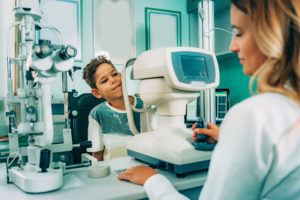November 1, 2020
By Dwight Akerman, OD, MBA, FAAO, FBCLA
 Given the increase in the prevalence of myopia worldwide and the associated risks of ocular pathology, there is a growing need for strategies to slow myopia progression and ultimately stop myopia onset. As myopia typically develops in childhood, the most straightforward and most accessible form of correction is a spectacle lens.
Given the increase in the prevalence of myopia worldwide and the associated risks of ocular pathology, there is a growing need for strategies to slow myopia progression and ultimately stop myopia onset. As myopia typically develops in childhood, the most straightforward and most accessible form of correction is a spectacle lens.
This systematic literature review investigated the association between un-, under- and over-correction of myopic refractive error and myopia progression in children and adolescents up to 18 years of age. Eight prospective cohort studies and one retrospective analysis of clinical data provided comparison data on un- and under-correction of myopia versus full correction of myopia.
A forest plot showed no beneficial effect of under-correction, with some studies finding an increase in myopia progression. There is no strong evidence of benefits from un-correction, monovision or over-correction. Hence, current clinical advice advocates for the full correction of myopia in children and adolescents up to 18 years of age.
Abstract
Nicola S Logan PhD BSc, James S Wolffsohn PhD MBA BSc DipAdvClinOptom
This systematic review investigates the association between un‐, under‐ and over‐correction of myopic refractive error and myopia progression in children and adolescents (up to 18 years of age). The literature search included three databases (PubMed, Web of Science and Cochrane Central Register of Controlled Trials [CENTRAL]), and reference lists of retrieved studies in any language. Eight prospective cohort studies and one retrospective analysis of clinical data provided comparison data on un‐ and under‐correction of myopia versus full correction of myopia; however, the quality of studies and length of follow‐up times varied. A forest plot showed no beneficial effect of under‐correction with some studies finding an increase in myopia progression. While one study suggested that myopia progression is slower in an un‐corrected cohort compared to those who are fully corrected, another study suggests the opposite. One study utilised anisomyopes to allow comparison of under‐correction of one eye with full correction of the fellow eye indicating that under‐correction in one eye appears to slow the rate of myopia progression in that eye. Another study on full correction only in one eye found that progression was faster in the un‐corrected eye. No benefits of over‐correction of myopia was found. The overall findings are equivocal with under‐correction causing a faster rate of myopia progression. There is no strong evidence of benefits from un‐correction, monovision or over‐correction. Hence, current clinical advice advocates for the full correction of myopia. Further studies are warranted to determine the level of myopia that can be left uncorrected without impacting on myopia progression and how this changes with time.
Logan, N. S., & Wolffsohn, J. S. (2020). Role of un‐correction, under‐correction and over‐correction of myopia as a strategy for slowing myopic progression. Clinical and Experimental Optometry, 103(2), 133-137.
DOI: https://doi.org/10.1111/cxo.12978











